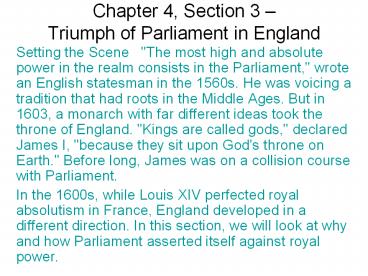Chapter 4, Section 3 PowerPoint PPT Presentation
Title: Chapter 4, Section 3
1
Chapter 4, Section 3 Triumph of Parliament in
England
- Setting the Scene "The most high and absolute
power in the realm consists in the Parliament,"
wrote an English statesman in the 1560s. He was
voicing a tradition that had roots in the Middle
Ages. But in 1603, a monarch with far different
ideas took the throne of England. "Kings are
called gods," declared James I, "because they sit
upon God's throne on Earth." Before long, James
was on a collision course with Parliament. - In the 1600s, while Louis XIV perfected royal
absolutism in France, England developed in a
different direction. In this section, we will
look at why and how Parliament asserted itself
against royal power.
2
I. The Tudors and Parliament
- From 1485 to 1603, England was ruled by the Tudor
dynasty
The Tudor dynasty or House of Tudor is a series
of five monarchs of Welsh origin who ruled
England and Ireland from 1485 until 1603. The
three main monarchs (Henry VII, Henry VIII and
Elizabeth I) each played an important part in
turning England from a European backwater still
immersed in the Middle Ages into a powerful
Renaissance state that in the coming centuries
would dominate most of the planet.
3
I. The Tudors and Parliament
- The Tudors believed in divine right but also
recognized the value of Parliament
Henry VII Henry VIII Elizabeth I
4
I. The Tudors and Parliament
- Like King Henry VIII, his daughter Elizabeth I
both consulted and controlled Parliament
5
II. The Early Stuarts
- Elizabeth died in 1603 without an heir and the
throne passed to the Scottish Stuarts, resulting
in a "century of revolution"
6
A. The Royal Challenge
- The Stuart monarch, James I, agreed to rule
according to English laws and customs but also
believed in divine right
7
A. The Royal Challenge
- Facing opposition over funding, James dissolved
Parliament
8
A. The Royal Challenge
- James disputed with dissenters such as the
Puritans, who sought to "purify" the Anglican
church
9
A. The Royal Challenge
- James called for a new translation of the Bible,
resulting in The King James Version
10
B. Parliament Responds
- In 1625, Charles I inherited the throne and
behaved like an absolute monarch
11
B. Parliament Responds
- Parliament forced Charles to sign the Petition of
Right, but then Charles dissolved Parliament in
1629
12
B. Parliament Responds
- When the Calvinist Scots revolted in 1640,
Charles had to summon Parliament to vote on
funding
13
C. The Long Parliament
- The 1640 Parliament became known as the Long
Parliament because it lasted until 1653
14
III. The English Civil War
- When Parliament tried and executed his chief
ministers, Charles fought back and civil war
ensued
15
A. Cavaliers and Roundheads
- Supporters of Charles I were wealthy nobles known
as Cavaliers
16
A. Cavaliers and Roundheads
- The forces of the Parliament were called
Roundheads and their leader was Oliver Cromwell
17
A. Cavaliers and Roundheads
- By 1647, the Roundheads defeated the Cavaliers
and Charles I was captured
18
B. Execution of a King
- Parliament put King Charles I on trial and
condemned him to death, executing him in January,
1649
19
IV. The Commonwealth
- Oliver Cromwell took the title of Lord Protector
and abolished the monarchy, the House of Lords,
and the Church of England
20
A. End of the Commonwealth
- Oliver Cromwell died in 1658 and in 1660, a new
Parliament put Charles II on the throne
21
V. From Restoration to Glorious Revolution
- Charles shared his father's belief in absolute
monarchy and secretly had Catholic sympathies
22
A. A New Clash With Parliament
- Charles's brother, James II, inherited the throne
in 1685 and many feared that he would restore the
Catholic Church
23
A. A New Clash With Parliament
- In 1688 parliament invited James's Protestant
daughter, Mary and her husband, William III of
Orange, to become rulers of England
24
A. A New Clash With Parliament
- When William and Mary landed with their army,
James II fled to France - the Glorious Revolution
25
B. English Bill of Rights
- William and Mary had to accept the English Bill
of Rights, which ensured the superiority of
Parliament over the monarchy
26
B. English Bill of Rights
- The Toleration Act of 1689 granted limited
religious freedom to Puritans, Quakers, and other
dissenters, though not Catholics

